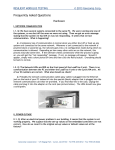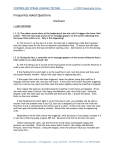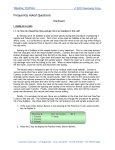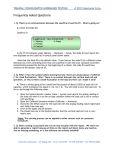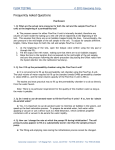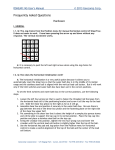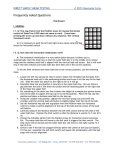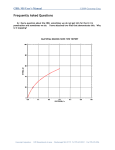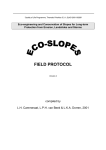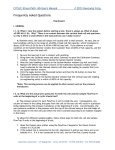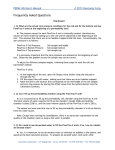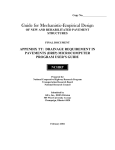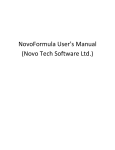Download Frequently Asked Questions
Transcript
ICON: MS User's Manual © 2013 Geocomp Corp. Frequently Asked Questions Hardware I. LIMIT SWITCHES I-1. Q: The platen moves down at the beginning of the test until it triggers the lower limit switch. Then the test stops and an error message appears on the screen indicating that the lower limit switch is on. Why is this happening? A: This occurs if, at the start of a test, the load cell is registering a load that is greater than the target value for the first incremental consolidation step. To ensure that this does not happen, always zero the load cell before starting a test. (See Section 6.2 for the zeroing procedure.) I-2. Q: During the test, a controller error message appears on the screen telling me that a limit switch is on. What should I do? A: First click the OK button on the error message window to close the window. What you do next depends on what caused the platen to reach a limit switch. If the upper limit switch has been reached, probably the test was started with the platen too high. In this case, you will have to lower the platen, lower the load cell and restart the test. (Be sure to either delete the test file for the test that was not completed or rename it so that it is easily identified as an incomplete test.) If the lower limit switch has been reached, probably the load cell had not been zeroed at the beginning of the test and was reading a load greater than the first incremental consolidation step. To correct this situation, zero the load cell (see Section 6.2 for the zeroing procedure) and then start the test again. II. NETWORK COMMUNICATION II-1. Q: There is no communication between the LoadTrac-II and the PC. What is going on? A: Check that the Node ID on the LoadTrac-II matches the one in the ICONP software program. The Node ID on the LoadTrac-II LCD is at the upper right corner as seen in the example below. Geocomp Corporation · 125 Nagog Park · Acton, MA 01720 · Tel 978-635-0012 · Fax 978-635-0266 ICON: MS User's Manual © 2013 Geocomp Corp. On the ICONP software program, pull down the Options menu then select Hardware. The Node ID will be shown in the top text field on the Hardware Setup window that will appear (see sample window below). If the IDs do not match, change the Motor Node ID value shown on the Hardware Setup window to that on the LCD. Click Apply then click OK. II-2. Q: We have several systems connected to the same PC. We were running only one of the systems, so we shut off the ones we were not using. Then we got an error message stating that the system we had left on was not responding. It seems that we lost communication. What is happening? A: A temporary loss of communication is normal when you either shut off or boot up any system unit connected to the same network. Whenever a unit connected to the network is powered down or powered up, the network goes into a re-configuration mode during which no communication is allowed. Depending on how many other units are on the network, this process may take some time. If the software checks connections while the process is going on, you will get the “not responding” message. If not, no message will appear. Should it appear, simply wait a short period of time and then click the Retry button. Everything should be back to normal. II-3. Q: The Network LEDs are RED on the front panel of the LoadTrac-II unit. There is no communication between the PC and the unit. Our ID number is correct. What else should we check? A: Probably the network communication cable (gray cable) is plugged into the Ethernet jack on the back of your PC instead of into the special (black) adapter that is plugged into the network communication card that we provided. If you find that this is the case, unplug the cable and plug it into the adapter on the card (see picture below). The LEDs should now glow a solid green. Geocomp Corporation · 125 Nagog Park · Acton, MA 01720 · Tel 978-635-0012 · Fax 978-635-0266 ICON: MS User's Manual © 2013 Geocomp Corp. II-4. Q: While starting the test, the machine will ask "Position Platen?" When I press "Yes," the LoadTrac-II should move the platen up until it just touches the load cell, but how do I know whether the load cell is being touched? (The computer immediately asks me to "Press OK when ready," but I am not aware of any other indication that the proper condition for starting the test has been reached.) A: When you press “Yes,” the green LED for Motor Up will come on, you will hear the stepper motor in the load frame start to run and the platen will move up until the LoadTrac-II system senses a very small load that typically is less than 0.002 kN (0.50 lb). (If the sample starts out very close to the load cell, the upward motion of the platen may not be very noticeable.) As soon at the small load is sensed, the green LED will turn off and the stepper motor will stop. These are the indications that the condition for starting the test has been reached. III. POWER OUTAGE III-1. Q: After an electrical power problem in our building, it seems that the system is not working properly. We suspect that the set-up values on the embedded controllers are not correct. How do we revert to the original set-up values or default values set at the factory? A: The default values may change either after an electrical power problem such a power surge or brown out or due to inadvertent actions by an inexperienced end user. You will need to revert back to the internal default values of your system by following these steps: 1. Turn off the LoadTrac-II unit. 2. Wait about 10 sec. 3. Turn it back on and immediately press the ESC key on the keypad to reset everything back to the imbedded controller default values. 4. Now go to your LoadTrac-II hardware manual. In Section 2.1.4 (Setup) of the manual, you will find a table of default settings for your system. Go through each LCD menu and be sure the settings on the menu agree with those in the table. If a setting does not agree, change it to the one in the manual. 5. If the Node ID number on your unit was changed (because you are controlling more than one system with your computer), set it to the value it was changed to. (The default value for LoadTrac-II is 65.) Geocomp Corporation · 125 Nagog Park · Acton, MA 01720 · Tel 978-635-0012 · Fax 978-635-0266 ICON: MS User's Manual © 2013 Geocomp Corp. III-2. Q: Can we turn off the PC while the test is running (because this test is timeconsuming)? A: No, absolutely NOT. But you can use other windows programs while the test is running and you can turn off just the monitor. IV. SAMPLE PREPARATION IV-1. Q: This is our first time that we are preparing a consolidation sample. Do you have any recommendation? A: Preparing a sample for testing in a LoadTrac-II system is similar to preparing the sample for a test performed manually. The difference is that the results of measurements you will make during the preparation must be entered into the ICONP program by way of the Specimen page and Water Content page of the Properties Sheet. Each consolidometer cell contains a stainless steel consolidation ring that is used to hold the sample. Remove the consolidation ring. Note the knife edge of the ring (see picture at right). This serves as a cutting edge while you are getting the sample into the ring, but also it must be at the top of the sample during the test as the edge serves to center the sample within the cell. If this is the first time the ring has been used, measure its inside diameter and height to the nearest 0.1 mm (0.004 in) using a precision caliper. Type the results of these measurements into the Initial Diameter and Initial Height text fields on the Specimen page. Weigh the ring to the nearest 0.01 gm and type the resulting value into the Specimen Tare Weight text field on the After Test section of the Water Content page. (If the ring has had previous use and you know its dimensions and weight, you can use this information.) Lightly coat the inner wall of the consolidation ring with vacuum grease. Your objective now will be to push the ring into your soil sample with as little disturbance to the sample as possible. The sample must have a larger diameter than the inside diameter of the ring and be taller than the ring. Set the sample on a flat surface, and with your hand press the ring straight down into the sample taking care that it does not tilt to one side or the other. As you press the ring down, you may have to use a tool to trim away the excess soil outside the ring (see picture above). Do not discard the trimmings. Alternatively, with the right setup it is possible to extrude a sample directly from a tube into the sample ring. With some care you can extrude 40 mm to 50 mm (1.6 to 2.0 inches) of sample. Geocomp Corporation · 125 Nagog Park · Acton, MA 01720 · Tel 978-635-0012 · Fax 978-635-0266 ICON: MS User's Manual © 2013 Geocomp Corp. Once you have pressed the sample ring completely into the sample so that a portion of the sample is above the top of the ring, use a wire saw to trim off excess material from the top and bottom of the sample so that the material is flush with the edges of the ring. Take care to trim both ends of the sample as cleanly and evenly as possible. Do not discard the trimmings. When you have finished, you should have a sample that has the diameter of the inside of the ring and the height of the ring. Thoroughly clean any soil from the exterior of the ring. Weigh the combination of ring and sample to the nearest 0.01 gm. Now subtract the weight of the ring from the weight of the ring-sample combination and type the result into the Initial Sample Weight text field on the Specimen page. Place a moist piece of filter paper trimmed to the sample diameter on the bottom of the sample. Remove the bottom stone from the cell and place the sample plus ring onto it being sure that the knife edge of the ring is up. Take care to avoid movement of the sample within the ring. Now carefully place the combination of bottom stone and sample into the cell so that the stone fits into the recessed bottom of the cell. The sample ring should be in the center of the bottom stone. Place a moist piece of filter paper trimmed to the sample diameter on the top of the sample. Install the centering ring and add the knurled nuts. Tighten the nuts hand tight making sure that the sample is properly centered. Position the top cap of the cell so that it is properly seated. You have now completed the preparation of the sample. Immediately after completing the procedure described above, select a representative sample of the trimmings that were left after you pushed the ring into the sample and the trimmings that came from the ends of the sample. You will need to put the trimmings in a container (e.g., a large evaporating dish) so that they can be dried. The container is referred to as the tare. The results of the measurements described below will be put in the text fields of the Before Test section of the Water Content page. First, mark the container with some identifying label and type this label into the Trimmings Tare ID text field. Next, weigh the container to the nearest 0.01 gm and type the resulting value into the Trimmings Tare Weight text field. Now put the sample of trimmings into the container and weigh the combination of trimmings and container to the nearest 0.01 gm. Type the resulting value into the Trimmings Wet Weight text field. Finally, dry the trimmings in an oven and again weigh the combination to the same accuracy as specified above. Type the resulting value into the Trimmings Dry Weight text field. (The ICONP program will perform the necessary calculations to obtain the before-test water content of the trimmings which should be the same as the before-test water content of the sample.) Geocomp Corporation · 125 Nagog Park · Acton, MA 01720 · Tel 978-635-0012 · Fax 978-635-0266 ICON: MS User's Manual © 2013 Geocomp Corp. Software I. CALIBRATION/ZEROING I-1. Q: When I view the system before starting a test, there is always an offset of about ±0.005 kN (1 lb). Why? There is no contact between the vertical load cell and specimen, so why is there a small offset in the load and how can I make it zero? A: Between tests, the load cell output can drift a small amount. At best, the no-load condition will be in the range of ±0.025% of load cell full capacity, which translates to about ±0.001 kN (±0.25 lb) for a 4.45 kN (1000 lb) load cell. If you observe a no-load condition on the System Monitor window that is greater than ±0.025% of full capacity, use the following steps to zero the load cell. 1. Be sure the load cell is not in contact with anything. 2. Bring down the Calibrate menu and select Summary to open the Calibration Summary window. Position this window beside the System Monitor window. 3. Note the Load reading in counts on the System Monitor window (top left text field). 4. Replace the Offset value that is shown on the Calibration Summary window (when Load is selected for the Channel choice) with the Load reading (in counts) that is on the System Monitor window. 5. Click the Apply button, the Download button and then the Ok button to close the Calibration Summary window. 6. You should now see in the System Monitor window that the vertical load cell reading (in engineering units) is within ±0.025% of full capacity. *Note: This zeroing process can be applied to other sensors such as a pressure transducer. I-2. Q: When I start a test, the program gives me an error message that the calibration factor is too small. I cannot run the test. I checked the calibration summary table and all values for the calibration factors are there. However the LVDT calibration factor has a negative sign. Is this where the problem is and if so, what do I do about it? A: The software does not accept zeros or negative numbers for the calibration factors in the calibration summary. The most convenient way to calibrate the LVDT is to add gage blocks between the LVDT shaft and the stop. When this is done, the output signal decreases for each increment and the resulting calibration factor is negative. All that is needed is to remove the negative sign in the summary table and everything should work correctly. Geocomp Corporation · 125 Nagog Park · Acton, MA 01720 · Tel 978-635-0012 · Fax 978-635-0266 ICON: MS User's Manual © 2013 Geocomp Corp. I-3. Q: In many of our different test files, the calibration values in the Summary Table and the values in each sensor's individual calibration table are not in sync. Could you please explain which values the program uses, and how to make sure they are correct? A: When running a test, the ICONP software uses only the parameters that are shown in the Calibration Summary. A mismatch between these values and those on the Calibrate window for a particular sensor can occur if the Calibrate window values have not been saved by clicking the Save button on that window. To determine whether or not the Summary values are correct, you need to know how the test was set up. The two possibilities are described below. The parameters are correct You have two LoadTrac-II units, A and B. You plan to run a test on unit A. A file for a test run on unit B is a good template for the test, but the calibration parameters in it are those for the sensors on unit B. You open an ICONP control window and load that file into the window. We will call that file Test-B. Next, you open a second ICONP control window and load into it a file for a test that was run on unit A. We will call that file Test-A. Finally, you copy the calibration parameters from the Calibration Summary in Test-A and paste them into the Calibration Summary in Test-A. You now have a control program that contains the correct calibration parameters for running a test on unit A, but those shown on the Calibration Summary will be different from those on the individual sensor Calibrate windows. The parameters are not correct You have two LoadTrac-II units, A and B. You plan to run a test on unit A. A file for a test run on unit B is a good template for the test, but the calibration parameters in it are those for the sensors on unit B. You open an ICONP control window and load that file into the window. We will call that file Test-B. You decide to calibrate the sensors and use Test-B to do it. You go through the calibration procedure for each sensor and click the Calibrate button on each Calibrate window. But you forget to click the Save button on each window before closing it. Geocomp Corporation · 125 Nagog Park · Acton, MA 01720 · Tel 978-635-0012 · Fax 978-635-0266 ICON: MS User's Manual © 2013 Geocomp Corp. You now have a control program that has the correct calibration parameters on each Calibrate window, and they will be different from those in the Calibration Summary. However, it is the incorrect Summary values that will be used to run the test. If you know (or suspect) that a test was run using a file with incorrect calibration parameters on the Summary window, you can recover from the error. Error Recovery Open an ICONP control window and load the erroneous test file into it. You will need to replace the calibration parameters (factor and offset) that are shown on the Calibration Summary with correct ones. If you are certain that the parameters on the individual Calibrate windows are correct, simply click Save on each of those windows. If you will have to enter new values manually, there are two ways to do this: (1) delete the original values and type the new ones into the text fields or (2) copy and paste the new ones. For the second option, you will need to open a second copy of ICONP and load the test file that contains the correct calibration parameters. Finally, save the file and reload it. The new values will be applied to the processed data. *Note: The raw data and the results of data reduction shown on the report pages will be changed. The stress target values that were entered into the Consolidation Table page will not be changed. I-4. Q: I used our calibrated gauge blocks to check our displacement sensor on the load frame. It appears to give readings roughly one half the actual distance. I double checked that the calibration factor (in/cnt) from the certificate you gave us is in both the load frame and the software (factor = 3.6498841x10-5). Does this factor seem to be off by a factor of two, based on the other similar sensors you have calibrated? A: The calibration factor is correct. The problem you describe can be caused by an incorrect setting for the polarity of the displacement sensor. It has to be Unipolar, not Bipolar. Use the keypad and LoadTrac-II LCD (see illustration below) to make the change as described in the following steps. 1. Use the arrow keys to select option 4, Setup, on the LCD screen. Geocomp Corporation · 125 Nagog Park · Acton, MA 01720 · Tel 978-635-0012 · Fax 978-635-0266 ICON: MS User's Manual 2. 3. 4. 5. 6. © 2013 Geocomp Corp. From the Setup options, select option 3, A/D Setup. From the A/D Setup options, select option 2, Channel 2. From the Channel 2 options, select option 2, Polarity. Of the two polarity options, select Unipolar. Finally, turn off the LoadTrac-II and then back on for the changes to take effect. I-5. Q: Can I apply a new calibration factor to a previous test that I have already run and get the correct results? A: Yes, you can. Open the ICONP program and load the file for the test you had already run. You will need to replace the calibration parameters (factor and offset) that are shown on the Calibration Summary with the new ones. There are two ways to do this: (1) delete the original values and type the new ones into the text fields or (2) copy and paste the new ones. For the second option, you will need to open a second copy of ICONP and load the test file that contains the new calibration parameters. Save (using the Save or Save As option in the ICONP file menu) the altered test file. When you load that file again, the new parameters will have been applied to the processed data. *Note: The raw data and the results of data reduction shown on the report pages will be changed. The stress target values that were entered into the Consolidation Table page will not be changed. II. CONSOLIDATION II-1. Q: What settings do we have to change to obtain secondary consolidation properties? A: You need to increase the T100 offset value so that there will be time for the secondary compression of the particular soil type you are testing to take place. The T100 Offset value (see illustration below) should be at least 10 times the value of T100 (calculated by ICONP during a step). This will give the program time to calculate a good value for the slope of the secondary consolidation curve/line. Before starting a test, you should estimate how long it will take to reach the T100 condition. Then, when you fill in the Consolidation Table, use a Minimum Duration time Geocomp Corporation · 125 Nagog Park · Acton, MA 01720 · Tel 978-635-0012 · Fax 978-635-0266 ICON: MS User's Manual © 2013 Geocomp Corp. that is somewhat longer than your estimate. During a step, you can watch its progress using options from the View menu. Choose the T100 option to find out the T100 value for that step. When you know what it is, you can change the T100 Offset value for that step to be 10 times the value. II-2. Q: I am processing the data from the consolidation test we ran on a new load frame. From the looks of the results, it appears that when the data are dumped in engineering units, the compression of the machine is NOT accounted for in the data that have been dumped. Is this correct? A: Yes, that is correct. Compensation for machine compression is not applied to dumped data. Dumped data includes only raw data values. To view the corrected data, bring down the Report menu and select Table. You can than look at all of the corrected results by opening the various pages using the options on the View menu (upper left corner of a page) or the Page Down, Page Up keys on your keyboard. II-3. Q: I noticed that when running a test on a soft soil sample it takes a relatively long time for the load to reach the specified value. How can I change the rate at which the load is applied? A: The rate at which a load is applied is controlled by the PID (Proportional gain, Integral gain and Derivative gain) parameters. They are shown on the Load PID Settings window that is opened by selecting PID from the Options menu. Both the Proportional Gain (P-Gain) and Integral Gain (I-Gain) affect the overall rate at which the target load is reached, but in somewhat different ways. An increase in value increases the rate; a decrease in value decreases the rate. The possible value range for P-Gain is from 0.5 to 5 and will change the loading time by about a factor of 3 from the lowest value to the highest. While the default values (2.5 for P-Gain and 0.2 for I-Gain) are appropriate for most soil types, it may be helpful to increase the P-gain to a maximum of 5 for a very soft soil specimen. The I-Gain should not be changed. To change the P-Gain setting, select PID from the Options menu to open the Load PID Settings window. Change the Proportional Gain setting to a higher value, click the Apply button and then close the window. II-4. Q: How do I increase the responding time for the loading in the consolidation? A: The rate at which a load is applied is controlled by the PID (Proportional gain, Integral gain and Derivative gain) parameters. They are shown on the Load PID Settings window that is opened by selecting PID from the Options menu. Both the Proportional Gain (P-Gain) and Integral Gain (I-Gain) affect the overall rate at which the target load is reached, but in somewhat different ways. An increase in value increases the rate; a decrease in value decreases the rate. The possible value range for P-Gain is from 0.5 to 5 and will change the loading time by about a factor of 3 from the lowest value to the highest. Geocomp Corporation · 125 Nagog Park · Acton, MA 01720 · Tel 978-635-0012 · Fax 978-635-0266 ICON: MS User's Manual © 2013 Geocomp Corp. While the default values (2.5 for P-Gain and 0.2 for I-Gain) are appropriate for most soil types, it may be helpful to increase the P-gain to a maximum of 5 for a very soft soil specimen. The I-Gain should not be changed. To change the P-gain setting, select PID from the Options menu to open the Load PID Settings window. Change the Proportional Gain setting to a higher value, click the Apply button and then close the window. II-5. Q: If we set the maximum time for one loading step to 24 hours, will the machine stop the step after it detects that the displacement reading has become constant? We set 10 loadings for the test and now, after almost 16 hours, it reached number 8. Can you explain what criteria the machine uses to stop a certain step? A: The termination of a test step does not depend on the displacement reading reaching a constant value. It depends on Tmin, Tmax, T100 Offset (entered on the Consolidation Table) and the T100 calculated by the control program. The graphs below show a consolidation curve and various quantities related to a test. Note that the horizontal time axis is the square root of time for the first curve and is time on a logarithmic scale for the second curve. The T100 value is shown on the second graph (the time at U = 100%) as almost 80 min. Geocomp Corporation · 125 Nagog Park · Acton, MA 01720 · Tel 978-635-0012 · Fax 978-635-0266 ICON: MS User's Manual © 2013 Geocomp Corp. 0.1400 D0 = 0.1500 (U=0%) 0.1500 0.1600 Dial reading (in) 0.1700 Line 2 0.1800 0.1900 Line 1 D90 = 0.1980 (U=90%) 0.2000 0.2100 d 1.15d 0.2200 t90 = (6.0)2 = 36.0 min 0.2300 0 5 t90 10 15 20 25 Square root of time (min1/2 ) 30 35 40 0.1400 0.1500 A 0.1600 C=A-(B-A) = D0 = 0.1490 (U=0%) x x B Line 1 Dial reading (in) 0.1700 D50 = (D0+D100)/2 D50 = 0.1790 0.1800 0.1900 0.2000 D100 = 0.2090 0.2100 0.2200 Line 2 tp (U=100%) 0.2300 0.1 1 t50 = 9.5 min 10 100 Log of time (min) 1000 10000 While the program is running a step, it calculates the T100 value for that step. When the T100 time has been reached, the program checks the Minimum Duration (Tmin), Maximum Duration (Tmax), and T100 Offset values in the Consolidation Table. If T100 < Tmin, the program will wait until the time Tmin is reached, continue an additional time equal to the T100 Offset, and then automatically move to the next step. Example 1: The values of Tmin = 60 min, Tmax = 1440 min (24 hr) and T100 Offset = 300 min (5 hr) are entered by the user. T100 calculated by the program is 30 min (which is < Geocomp Corporation · 125 Nagog Park · Acton, MA 01720 · Tel 978-635-0012 · Fax 978-635-0266 ICON: MS User's Manual © 2013 Geocomp Corp. Tmin). The step will last 60 min (Tmin) + 300 min (T100 Offset) = 360 min (6 hr), which is less than Tmax = 1440 min. If T100 > Tmin, the program will continue the step an additional time equal to the T100 Offset, then automatically move to the next step. Example 2: The values of Tmin = 60 min, Tmax = 1440 min (24 hr) and T100 Offset = 600 min (10 hr) are entered by the user. T100 calculated by the program is 120 min (which is > Tmin). The step will last 120 min (the calculated T100) + 600 min (the T100 Offset) = 720 min (12 hr), which is less than Tmax = 1440 min. If Tmax is reached before the end of the T100 Offset period, the program will automatically move to the next step. Example 3: The values of Tmin = 120 min, Tmax = 1440 min (24 hr) and T100 Offset = 1200 min (20 hr) are entered by the user. T100 calculated by the program is 300 min (5 hr) (which is > Tmin). The step will last 1440 min (the Tmax value) because 300 min (the calculated T100) + 1200 min (the T100 Offset) = 1500 min (25 hr), which is greater than Tmax = 1440 min. *Note: These T values can be different for each step, and the T values for subsequent steps can be changed EVEN during a test. If going to a secondary consolidation is not needed and the T100 Offset value is set at zero, each step could be quite short (60 min in Example 1 above with a T100 Offset = 0). It is very unusual for a step to go as long as 24 hr and quite common for an entire test to take less that 24 hr. II-6. Q: What are the recommended values for the maximum and minimum duration time for the consolidation tests? Geocomp Corporation · 125 Nagog Park · Acton, MA 01720 · Tel 978-635-0012 · Fax 978-635-0266 ICON: MS User's Manual © 2013 Geocomp Corp. A: The recommended values for different types of soils are shown in the table below. Recommended Duration Settings for a Consolidation Test Soil Type Sandy silt Silty Clay Plastic Clay Recommended Max. Duration Recommended Min. Duration 1440 min (24 hours) 30 min 1440 min (24 hours) 60 min 1440 min (24 hours) 120 min II-7. Q: Is there a way to run the swell test using the existing iconp software? A: If your soil sample has a tendency to swell; then you must specify the first step as constant volume. The program automatically increases the load to keep the volume constant. Once the swell is under control It will then proceed to the next step that is higher than the swell pressure determined. III. GENERAL III-1. Q: Can the software detect wrong values that are manually entered by the end user? A: Yes, the software program detects any erroneous values that have been entered. It also detects certain hardware malfunctions. Examples include: 1. Negative values for sample dimensions, calibration factors, and PID control parameters 2. Zero values for sample dimensions, calibration factors (except for offset value), and PID control parameters 3. Wrong Node ID number Geocomp Corporation · 125 Nagog Park · Acton, MA 01720 · Tel 978-635-0012 · Fax 978-635-0266 ICON: MS User's Manual © 2013 Geocomp Corp. 4. A malfunctioning sensor that it is giving an analog reading of either 0 (the minimum value) or 65535 (the maximum value) 5. Any load frame that is not on. III-2. Q: I am running a test. Do I need to wait until the end of the test to see the results? A: You do not need to wait until the end of the test. While the test is running: 1. Go to the File menu. 2. Select and click on Load. 3. Go to the Report menu. You will be able to see the partial test results up to the point when you did the Load. 4. Repeat the above steps as the test progresses. III-3. Q: I noticed that the engineering readings on the LCD screen are different than the ones on the PC screen. Are they supposed to be the same? Did it affect the results of a test I just ran? A: First, be assured that any mismatch of the engineering readings values between the LCD and the PC screens will not affect the results of a test that you run using the ICONP program. A mismatch can occur if the calibration parameters that are shown in the Calibration Summary (opened using the Calibration menu) have not been downloaded into the imbedded controller of the LoadTrac-II unit. However, the software uses only the Calibration Summary values when it runs a test. Consequently, it is very important that these are correct. To synchronize the LCD and PC screen readings, you need to update the calibration parameters in the imbedded controller of the LoadTrac-II unit. To do this, follow the steps shown below. 1. Bring down the Calibrate menu and select Summary. 2. On the Calibration Summary window, select the sensor that you want to update (from the list shown when the pull-down button to the right of the top text field is clicked). Geocomp Corporation · 125 Nagog Park · Acton, MA 01720 · Tel 978-635-0012 · Fax 978-635-0266 ICON: MS User's Manual © 2013 Geocomp Corp. 3. Click the Download button. This will automatically transfer (copy and save) the current calibration parameters (Factor and Offset) for the selected sensor into the embedded controller. 4. Repeat the above procedure for each sensor. You should now see that the PC and LCD screen values match. III-4. Q: Does the data that is obtained through the dump feature include the machine calibration or is that raw data? A: The dumped data is raw data; it does not include any correction. IV.PID SETTINGS IV-1. Q: What are the effects and correlations between the PID values? A: The ICONP program uses a control technique that is very complex. Consequently it is difficult to explain in detail how the PID values are used. In general terms, as an applied load is reaching its target value, the program periodically gathers information and adjusts the loading rate by using the information and the PID (Proportional gain, Integral gain and Derivative gain) values. Both the Proportional Gain (P-Gain) and Integral Gain (I-Gain) affect the overall rate at which the load reaches the target value, but in somewhat different ways. An increase in value increases the rate; a decrease in value decreases the rate. As the load gets close to the target value, the P-Gain functions to decrease the loading rate so that the target value is not reached too suddenly. (Keeping the loading rate constant would be like hitting the specimen with a hammer.) On the other hand, I-Gain functions to increase the loading rate throughout the loading process. The values of these parameters that will produce the most rapid loading rate while preventing the target from being “hit” too rapidly differs for each soil type. The default values of 2.5 and 0.2 for the P-Gain and I-Gain respectively work well for most soil types. The graphs that are included in the answer to Q/A IV-2 below help to show the effects of the P-Gain and I-Gain. As can be seen, the I-Gain needs to be changed only for very stiff soils. Geocomp Corporation · 125 Nagog Park · Acton, MA 01720 · Tel 978-635-0012 · Fax 978-635-0266 ICON: MS User's Manual © 2013 Geocomp Corp. IV-2. Q: The software manual says that the Proportion Gain can be as high as 5 for soft soils and as low as 0.5 for stiff soils. Also, the Integral Gain should probably be set to 0.1 for very stiff samples. What other values might be used and how are we going to decide on the best values to use? Please clarify. A: It is possible to use any Proportional Gain (P-Gain) value from 0.5 to 5 and any Integral Gain (I-Gain) from 0.1 to 1. (The Derivative Gain value of 0 should not be changed.) The rate at which a load is applied at the beginning of a step depends on both the P-Gain and the IGain: lower value = slower rate, higher value = faster rate. The time to reach a target value increases by a factor of about 3 from a P-Gain of 0.5 to 5. The table below gives general guidelines for P-Gain settings. Sample stiffness LOOSE /VERY SOFT MEDIUM SOFT/MEDIUM DENSE/STIFF Recommended P-Gain value 5.0 2.5 0.5 In addition, the following information may help you to decide what value will be best for your sample. The graphs shown below are for loading curves generated during a test. (They were generated from data dumped into a file after the test.) Note that the time scale is not the same for the different soil types. When possible, the target load should be reached in less than 0.5 min. Consequently a high P-Gain setting is good for very soft soils. It is easy to reach the target load value for stiff soils. However (as seen in the last two graphs), the target value may not be reached smoothly. To help this situation, the I-Gain (or both the I-Gain and P-Gain) can be decreased. Geocomp Corporation · 125 Nagog Park · Acton, MA 01720 · Tel 978-635-0012 · Fax 978-635-0266 ICON: MS User's Manual © 2013 Geocomp Corp. Geocomp Corporation · 125 Nagog Park · Acton, MA 01720 · Tel 978-635-0012 · Fax 978-635-0266 ICON: MS User's Manual © 2013 Geocomp Corp. In addition, a “rule of thumb” for response time is given in Section 6.0 of ASTM standard D2435: Standard Test Methods for One-Dimensional Consolidation Properties of Soils Using Incremantal Loading. “Load application generally should be completed in a time corresponding to 0.01 t100 or less. For soils where primary consolidation is completed in 3 min, load application should be less than 2 s.” To find out what the T100 value is for a step in a test, open the Test T100 window (by choosing the T100 option in the View menu) at the beginning of the step. As soon as the ICONP program has gathered enough information, it will show the graphical determination of the T100 value on the window. It will also list the T100 value in the Test Monitor window. To change a PID setting click PID on the Options menu to open the Load PID Settings window. Replace the default value with the new value, click the Apply button and then close the window. V. REPORT V-1. Q: How do I print my tables and graphs after a test has been completed? A: To print the table or graph for a completed test, follow these steps: 1. Bring down the Report menu. 2. Select Table (or Graph). 3. Click on View at the upper left corner of the window that opens (see illustration below), then select print. V-2. Q: After running a successful test we ran into troubles with the report. We were not able to generate a report because all links on the report pull down menu are inactive. Are we missing something, or is the software not entirely installed? A: To make the links active, parameters and data for a test must be loaded into the ICONP program so that they can be displayed on the various ICONP windows. Go through the following steps to load a data file. 1. First pull down the File menu. Geocomp Corporation · 125 Nagog Park · Acton, MA 01720 · Tel 978-635-0012 · Fax 978-635-0266 ICON: MS User's Manual © 2013 Geocomp Corp. 2. Next, click on Load. This will display a window that shows data files for tests that have been completed (and for any test that is currently running). Highlight the file name for the test you wish to load and then click Open. 3. Finally, pull down the Report menu. You should now see the Graph, Table, Settings, and Edit options all activated. Using these options, you can view the results of the test, change various settings for the report and edit the test data points. Remember that each time you change or edit any item, you will need to save the file and load it again. V-3. Q: Does the program automatically determine the overburden pressure, the preconsolidation pressure, and the compression Index? A: No, those values are computed and determined by the end user as some may call for engineering judgment. Then you need to go to ReportSettings and manually enter them. The overburden pressure is unique to your particular application and depends on what it is you are studying. It is the pressure or stress imposed on a layer of soil or rock by the weight of the overlying material. The preconsolidation pressure cannot be measured directly but can be estimated through the e –log s’ curve. Refer to Cassagrande (1936) graphical method for estimating the preconsolidation pressure. The compression index can also be estimated graphically through the e –log s’ curve and is interpreted as the slope of the virgin consolidation curve. There are also several empirical Geocomp Corporation · 125 Nagog Park · Acton, MA 01720 · Tel 978-635-0012 · Fax 978-635-0266 ICON: MS User's Manual © 2013 Geocomp Corp. correlations that can be used to calculate the compression index directly based on soil properties, e.g., LL and initial void ratio. The table below gives some of these correlations. VI. SATURATION VI-1. Q: Why is my final saturation value higher than 100%? A: This value is sensitive to several factors: The height and inside diameter of the ring The before and after weight (mass) of the sample The specific gravity of the sample If slightly inaccurate values for these quantities have been entered, the program calculation of the final saturation value could be higher than 100% For example, the actual ring diameter might be 63.22 mm (2.489 in) instead of 63.5 mm (2.500 in). Similarly, the height might be slightly different from the nominal value. For the best results of data reduction, we recommend that you carefully measure the dimensions of the ring using precision calipers. (This should have to be done only once, but checking the values periodically is a good idea.) Be sure to make all weight measurements to ±0.01 gm. You will need to make an accurate measurement of the specific gravity (or find an accurately measure value from some source. If you do not need to have an accurate saturation value, you can use the nominal ring dimensions and enter an estimated value for specific gravity (being sure to specify this type of value using the pull-down tab beside the Specific Gravity dialog box). Alternative, you can choose the option of Implied and let the ICONP program determine a reasonable value. *Note: If, for Specific Gravity, you leave 0 in the text field to the right when the designation in the box to the left is Measured or Estimated, the program will determine an implied value. Geocomp Corporation · 125 Nagog Park · Acton, MA 01720 · Tel 978-635-0012 · Fax 978-635-0266 ICON: MS User's Manual © 2013 Geocomp Corp. VII. SWELL VII-1. Q: In processing the information for the swell test, I noticed that the total load needed to maintain the constant volume does not show up on the table printout. The original applied load does, but the only place it shows up is on the graph, and from that it is difficult to tell the exact load that had to be applied. Is there anywhere to find what the exact load went up to? A: To find out the load reached during the swell step, you need to use the Dump selection in the File menu under File, following these steps: 1. Click on File then select Dump 2. Of the Dump options, select Engineering 3. Dump will generate an ASCII data file that can be saved on your hard drive and then viewed using either a spreadsheet program such as Excel or a text editor such as Notepad. VII-2. Q: We are looking to do some swell testing on a clay sample according to ASTM 4546, method C. My understanding is that this can be easily done with your equipment. How can we do it? A: The swell test is an excellent example of how the use of automation in soil testing saves time and effort. Instead of your having to apply increments of vertical stress as needed to prevent swell, the fully automated LoadTrac-II will apply the required load to keep the height to within ±0.005 mm (±0.0002 in) without any human intervention. The following steps describe what you need to do to run the test. 1. Prepare the sample as you would for a 1-D incremental consolidation test. 2. Open the Consolidation Table page of the Properties Sheet. Click on the pull-down tab at the right of each Step Type text field and select the Constant Volume option. 3. For each step, enter a target stress value (first column dialog boxes) that corresponds to the effective overburden stress. 4. Check all other entries on the pages of the Properties Sheet to be sure they are correct. Be sure that the LoadTrac-II sensors have the correct calibration factors. 5. Bring down the Run menu and click Start. VIII. WATER CONTENT VIII-1. Q: How do I enter the correct water content information? Geocomp Corporation · 125 Nagog Park · Acton, MA 01720 · Tel 978-635-0012 · Fax 978-635-0266 ICON: MS User's Manual © 2013 Geocomp Corp. A: You need to enter water content information on the Water Content page of the Properties Sheet opened by clicking on the Water Content tab. The Water Content page is divided into two sections, Before Test and After Test. Note that the term “Tare” used in both sections of the page refers to a container itself, not the tare value (i.e., empty weight) of the container. The term “Trimmings” refers to the portion of the sample that will be dried (either before the test begins or after the test is finished). Be sure to make all weight measurements to an accuracy of ±0.01 gm. Before Test This section of the page is used to enter measurements made on sample trimmings before the test begins. Trimmings Tare ID: This is the name, number or other identifying label of the container holding trimmings of the sample to be tested (e.g., ICON1, Test2, CanA, etc.). Trimmings Tare Weight: This is the measured weight of just the container identified above. Trimmings Wet Weight: This is the combined weight of the container (the tare) and the trimmings before they are dried. Trimmings Dry Weight: This is the combined weight of the tare and the trimmings after they have been oven-dried. After Test This section of the page is used to enter measurements made on the portion of the sample that was tested (the Specimen) after the test is finished. Specimen Tare ID: This is the ID for the consolidation ring that held the specimen during the test (typically just the word Ring). Specimen Tare Weight: This is the measured weight of just the empty consolidation ring identified above. (The measurement can be made either before the specimen is inserted or after the tested specimen has been removed from the ring.) Specimen Wet Weight: This is the combined after-test weight of the ring and the original wet sample. Be sure that it does not include the weight of the filter papers and porous stones. Trimmings Tare ID: This is the label (or name) of the container, usually a large evaporating dish, that will be used during the drying of the tested specimen. Trimmings Tare Weight: This is the weight of the container identified above. Trimmings Wet Weight: This the combined weight of the container (identified above) and the still-wet sample plug (the specimen) that has been carefully removed from the consolidation ring after the top and bottom filter papers have been removed. Geocomp Corporation · 125 Nagog Park · Acton, MA 01720 · Tel 978-635-0012 · Fax 978-635-0266 ICON: MS User's Manual © 2013 Geocomp Corp. Trimmings Dry Weight: this is the combined weight of the container and the specimen after being oven. The computer program uses information entered on the Water Content page to calculate the after test dry weight and the final water content of the sample. In addition, it uses information entered on the Specimen page to calculate the initial water content, and the initial and final values of the void ratio, the dry unit weight (density) and the saturation. *Note: In order for the outcome of the ICONP data reduction to be correct, be sure that accurate information has been entered on the Specimen page of the Properties Sheet as well as on the Water Content page. To open the Specimen page, click the Specimen tab on the Properties Sheet. Be sure the actual measured (±0.1 mm or ±0.004 in) diameter and height of the consolidation ring are entered (not just the nominal values). The Initial Sample Weight must be the difference between the accurately measured (±0.01 gm) ring-sample combined weight and that of the ring alone. An accurately measured value of the specific gravity needs to be entered if you want accurate void ratios and degrees of saturation for the test. If the plasticity of the sample is not known, the Unknown designation must be chosen. If the liquid limit and plastic limit are known, their values should be entered so that they will appear on the report table produced by the software. Geocomp Corporation · 125 Nagog Park · Acton, MA 01720 · Tel 978-635-0012 · Fax 978-635-0266
























